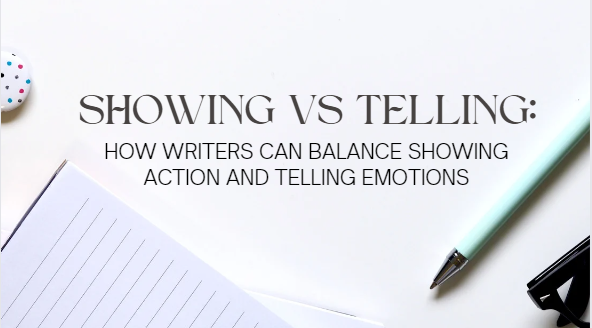Showing Vs Telling: How Writers Can Balance Showing Action and Telling Emotions
Many aspiring writers struggle to master the technique of showing vs telling in their work. Writing is an art, a delicate dance of words that paints vivid pictures in the reader’s mind. One of the most challenging aspects of this art is striking the right balance between showing action and telling emotions.
Too much of one can overshadow the other, leaving the narrative feeling flat or overly dramatic. In this article, we’ll delve into the intricacies of the showing vs telling balance and offer tips for writers to master this essential skill.
1. Understanding the Difference: Showing vs. Telling
Before diving into the balancing act, it’s crucial to understand the difference between showing vs telling.
Showing is about using descriptive language to paint a picture. It’s about allowing the reader to infer emotions or events from the details provided. For instance, instead of saying “John was angry,” you might write, “John’s face turned crimson, and his hands clenched into fists.”
Telling, on the other hand, is more direct. It’s when the writer explicitly states what’s happening or how a character feels. Using our previous example, “John was angry” is a clear instance of telling.
Both showing and telling have their places in storytelling. The key is to know when to use which.
Read: How to Write a Story
2. The Power of Showing Action
- Creates Immersion: Showing action immerses the reader in the scene. It allows them to visualise the events as they unfold, making the narrative more engaging.
- Builds Suspense: Detailed action sequences can build suspense, especially in genres like thrillers or mysteries. The reader is left on the edge of their seat, eagerly turning pages.
- Develops Characters: Actions speak louder than words. By showing a character’s actions, writers can reveal their motivations, desires, and fears.
3. The Importance of Telling Emotions
- Offers Clarity: While showing is immersive, telling provides clarity. It ensures that the reader understands the character’s emotional state.
- Speeds Up the Narrative: Not every scene requires a detailed description. Telling can help move the story along during less critical moments.
- Deepens Emotional Connection: Explicitly stating a character’s emotions can deepen the reader’s connection to them. It allows for empathy and understanding.
4. Striking the Balance
- Consider the Scene’s Purpose: Is the scene meant to be action-packed or emotionally charged? If it’s a high-octane chase, focus on showing the action. If it’s a heart-to-heart conversation, delve into the characters’ emotions.
- Use Dialogue Wisely: Dialogue can be a tool for both showing and telling. Characters can express their feelings (telling) or hint at them through subtle cues (showing).
- Vary Sentence Structure: Mix short, punchy sentences (great for action) with longer, more introspective ones (suited for emotions).
- Trust Your Reader: Readers are astute. They can pick up on subtleties. Don’t over-explain. Sometimes, a simple action or gesture can convey volumes about a character’s emotional state.
- Revise and Refine: Striking the perfect balance often comes in the revision stage. Once you’ve written your piece, go back and see where you might have shown too much or told too little. Adjust as necessary.
5. Examples in Literature
Many renowned authors have mastered the balance between showing vs telling. For instance, J.K. Rowling’s Harry Potter series is replete with action-packed sequences interspersed with deep emotional insights. Jane Austen, too, in Pride and Prejudice, expertly conveys the tumultuous emotions of her characters while keeping the narrative moving with events and actions.
6. The Pitfalls of Over-Showing
While showing is a powerful tool, it’s essential to be aware of its pitfalls.
- Overburdening the Reader: Too much description can overwhelm the reader, making them lose track of the main plot or the emotional essence of the scene.
- Slowing Down the Pace: Overly detailed action sequences can bog down the narrative, especially if they don’t serve the story’s primary purpose.
- Becoming Predictable: If every emotion is shown through actions, the narrative can become predictable. For instance, if a character always clenches their fists when angry, it loses its impact over time.
7. The Limitations of Over-Telling
Similarly, excessive telling has its drawbacks.
- Lack of Engagement: When emotions are always told, the reader becomes a passive observer rather than an active participant in the story.
- Missing Nuance: Telling can sometimes miss the nuances of emotion. Saying “She was sad” doesn’t capture the depth of her despair or the reasons behind it.
- Reducing Relatability: Readers connect with characters through their emotions. Over-telling can make characters feel distant or superficial.
8. Techniques to Enhance Showing
- Use Sensory Details: Engage the reader’s senses. Instead of saying “The room was tense,” describe the cold silence, the stiff postures, or the avoided eye contact.
- Play with Metaphors and Similes: These can be powerful tools to show emotions. “Her anger was like a storm, brewing and unstoppable” is more evocative than “She was very angry.”
- Focus on Body Language: A character’s posture, facial expressions, or gestures can reveal a lot about their emotional state.
9. Techniques to Refine Telling
- Be Specific: Instead of generic statements like “He was happy,” delve deeper. “He was elated at the news of his promotion” provides more context.
- Use Internal Monologues: Give readers a glimpse into the character’s thoughts. This can be an effective way to tell emotions without making it feel forced.
- Choose Strong Verbs: Instead of “She looked,” opt for “She glared” or “She gazed.” The choice of verb can convey a lot about the emotion behind the action.
10. The Role of Setting in Balancing Showing vs Telling
The setting can be a silent character in your story, playing a pivotal role in showing action and telling emotions.
- Reflecting Emotions: A gloomy, overcast sky can mirror a character’s sadness, while a bright, sunny day can amplify their joy.
- Enhancing Action: The setting can add layers to action sequences. A chase scene in a crowded market is different from one in a deserted alley.
- Setting as a Catalyst: Sometimes, the setting can act as a catalyst for emotions or actions. A character’s childhood home might bring back memories, triggering specific emotions or actions.
11. Feedback and Beta Readers
One of the best ways to ensure you’ve struck the right balance is to seek feedback.
- Fresh Eyes: After spending so much time with your manuscript, you might miss areas where the balance is off. A fresh set of eyes can provide invaluable insights.
- Diverse Readers: Different readers pick up on different things. Having a diverse group of beta readers can help identify areas where you might be over-showing or over-telling.
- Be Open to Criticism: Remember, feedback is about making your work better. Be open to suggestions and be willing to make changes.
12. The Evolution of Show vs. Tell
Over the decades, the preference for showing versus telling has evolved. Classic literature leaned more towards telling, with authors delving deep into characters’ psyche. Modern literature, influenced by cinema and television, often leans towards showing. Being aware of these trends can help writers decide how to balance the two based on their target audience.
13. The Role of Genre in Balancing Showing vs Telling
Different genres have different expectations when it comes to showing vs telling. Understanding these nuances can guide writers in their approach.
- Romance and Drama: These genres often delve deep into characters’ emotions. While showing is essential, especially in romantic scenes, telling can provide readers with insights into the characters’ innermost feelings.
- Action and Thrillers: Fast-paced and action-packed, these genres lean heavily on showing. However, moments of introspection, where the protagonist’s fears or motivations are told, can add depth.
- Fantasy and Sci-Fi: World-building is crucial here. While the action is shown, the rules of the world, the lore, or a character’s unique abilities might need to be told for clarity.
14. The Influence of Cultural Narratives
Cultural backgrounds can influence how emotions are expressed and perceived. This can play a role in the balance between showing and telling.
- Western Narratives: Often, Western stories value individual expression, leading to a preference for showing emotions through actions or dialogue.
- Eastern Narratives: In many Eastern cultures, emotions might be more subdued or internalized. Telling can be a way to give voice to these internal struggles.
- Bridging the Gap: For Creative Translation writers aiming for a global audience, understanding these cultural nuances can help in crafting a narrative that resonates universally.
15. The Impact of Modern Media
The rise of visual mediums like film and television has influenced readers’ expectations.
- Cinematic Influence: Modern readers often expect a cinematic experience, with vivid action sequences and palpable tension – a clear emphasis on showing.
- Inner Monologues in Film: While films show action, they often use voiceovers to tell a character’s thoughts, mirroring the balance found in literature.
- Adapting to Changing Times: Writers can learn from these mediums, understanding when to paint a vivid picture and when to delve deep into a character’s psyche.
16. Balancing Show and Tell in Short Stories vs. Novels
The length of the narrative can influence the balance between showing and telling.
- Short Stories: With limited word count, every word in a short story must count. While pivotal actions should be shown, emotions might often be told to conserve space and move the narrative forward.
- Novels: With more room to explore, novels can afford detailed action sequences and deep emotional introspections. The balance can be more fluid, shifting as the story demands.
17. The Role of Secondary Characters
Secondary characters can be instrumental in striking the balance between showing and telling.
- Reflecting the Protagonist: Through their interactions with the main character, secondary characters can show the protagonist’s emotions. For instance, a friend might notice the protagonist’s subtle mood changes, highlighting them for the reader.
- Offering a Different Perspective: Secondary characters can provide a contrasting viewpoint, telling their perceptions or feelings about events, which can offer a richer understanding of the narrative.
18. Workshops and Writing Groups
Joining a writing group or attending workshops can be beneficial in mastering the balance between showing and telling.
- Live Feedback: Reading your work aloud and getting immediate feedback can highlight areas where the balance might be off.
- Learning from Others: Listening to other writers’ works can offer insights into how they strike the balance, providing fresh perspectives and techniques.
- Constructive Critiques: A supportive writing group can offer constructive criticism, helping writers refine their skills and achieve the desired balance.
19. The Emotional Arc and Pacing
The story’s emotional arc and pacing play a pivotal role in determining when to show or tell.
- Climactic Moments: High-stakes or climactic scenes often benefit from showing, immersing readers in the moment.
- Downtime and Reflection: After an intense scene, characters (and readers) might need a breather. This can be a good time to tell, allowing characters to reflect on events and emotions.
- Building Tension: A mix of show and tell can build tension. While actions might escalate the conflict, telling can offer insights into the characters’ growing anxieties or fears.
20. The Role of Flashbacks and Memories
Flashbacks and memories offer unique opportunities to both show and tell within a narrative.
- Revealing the Past: Flashbacks can vividly show past events, providing context to current actions or decisions. This technique immerses readers in the character’s history.
- Emotional Resonance: Memories, on the other hand, can be used to tell a character’s emotional response to past events, offering depth and layers to their persona.
21. The Power of Subtext
Subtext is what’s unsaid, the underlying message beneath the surface. It’s a potent tool for balancing show and tell.
- Showing through Implication: Instead of directly showing or telling, writers can imply. For instance, a character avoiding a particular topic can show their discomfort or trauma related to it.
- Telling through Silence: Sometimes, what a character doesn’t say can tell more than their words. Silence, pauses, or hesitations can reveal hidden emotions or conflicts.
22. The Influence of Point of View (POV)
The chosen POV can significantly impact the balance between showing and telling.
- First Person: Being inside a character’s head allows for a seamless blend of showing and telling. The character can describe their actions while simultaneously revealing their emotions.
- Third Person Limited: This POV can show actions clearly while telling emotions becomes more nuanced, relying on the character’s perceptions.
- Third Person Omniscient: With an all-knowing narrator, there’s flexibility to both show actions across multiple characters and tell their emotions, offering a panoramic view of the narrative.
23. The Art of Foreshadowing
Foreshadowing is hinting at events that will occur later in the story.
- Showing through Clues: Dropping subtle hints through actions or settings can show readers that something significant is on the horizon.
- Telling through Premonitions: Characters might have a gut feeling or intuition about upcoming events, which tells readers to be on the lookout for future developments.
24. The Importance of Rhythm and Flow
The rhythm of prose can guide the balance between showing and telling.
- Action Sequences: Fast-paced, rhythmic prose can enhance action scenes, making them more dynamic and engaging.
- Emotional Reflections: Slower, more lyrical prose can be used to delve deep into a character’s emotions, allowing readers to pause and reflect alongside the character.
Wrapping Up on Balancing Showing Vs Telling
Balancing showing action and telling emotions is akin to a dance, with writers leading their readers through a choreographed narrative. By understanding the various techniques and tools at their disposal, writers can craft stories that not only entertain but also resonate on a profound emotional level. It’s a journey of continuous exploration, refinement, and growth, with the ultimate reward being a story that stands the test of time.
Author: Alva Chew





